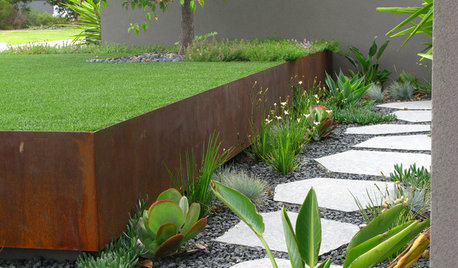Converting lawn to veggies; bermuda grass question
cdksd
10 years ago
Related Stories

GARDENING GUIDES5 Great Grasses for a New Lawn
Learn about maintenance, wear tolerance, ideal climate and more for these top turf choices to pick the right one for you
Full Story
SAVING WATERHouzz Call: Are You Letting Go of Your Lawn?
Many facing a drought are swapping turf for less thirsty plantings. If you’re one of them, we’d like to hear about it
Full Story
FRONT YARD IDEASBefore and After: Front Lawn to Prairie Garden
How they did it: Homeowners create a plan, stick to it and keep the neighbors (and wildlife) in mind
Full Story
GRASSESHow to Rock a Lawn
Weekend Project: The key to healthy grass begins with the soil. If turf works for you, here’s how to fix it and keep it looking its best
Full Story
LANDSCAPE DESIGN7 Questions to Ask Before Laying Stepping Stones
These broken-up pathways invite you to put a spring in your step — while adding functionality to the garden
Full Story
LANDSCAPE DESIGNIs It Time to Consider Fake Grass?
With more realistic-looking options than ever, synthetic turf can be a boon. Find the benefits and an installation how-to here
Full Story
EARTH DAYThe Case for Losing the Traditional Lawn
Work less, help the environment and foster connections by just saying no to typical turf
Full Story
GREAT HOME PROJECTSHow to Replace Your Lawn With a Garden
New project for a new year: Lose the turfgrass for energy savings, wildlife friendliness and lower maintenance
Full Story
BEFORE AND AFTERSSee 6 Yards Transformed by Losing Their Lawns
Wondering whether a turf lawn is the best use of your outdoor space? These homeowners did, and they found creative alternatives
Full Story
LANDSCAPE DESIGNGet Along With Less Lawn — Ideas to Save Water and Effort
Ditch the mower and lower your water bill while creating a feast for the eyes with diverse plantings and gathering places
Full StoryMore Discussions






bmiceli
cdksdOriginal Author
Related Professionals
Wareham Landscape Architects & Landscape Designers · Willowick Landscape Architects & Landscape Designers · Woodinville Landscape Architects & Landscape Designers · Cudahy Landscape Contractors · Edinburg Landscape Contractors · Glendale Heights Landscape Contractors · Middletown Landscape Contractors · North Plainfield Landscape Contractors · Oxnard Landscape Contractors · Saint Paul Landscape Contractors · Woodbury Landscape Contractors · Sun Valley Landscape Contractors · Leesburg Driveway Installation & Maintenance · Ocala Driveway Installation & Maintenance · Sunnyvale Driveway Installation & Maintenancedigdirt2
buford
mckenziek
seysonn